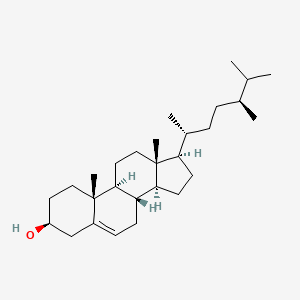| MeSH term | MeSH ID | Detail |
|---|---|---|
| Coronary Disease | D003327 | 70 associated lipids |
| Hypercholesterolemia | D006937 | 91 associated lipids |
| Hyperlipoproteinemia Type II | D006938 | 22 associated lipids |
| Hyperlipidemias | D006949 | 73 associated lipids |
| Hypolipoproteinemias | D007009 | 9 associated lipids |
| Xanthomatosis | D014973 | 17 associated lipids |
| Metabolic Syndrome | D024821 | 44 associated lipids |
22,23-dihydrobrassicasterol
22,23-dihydrobrassicasterol is a lipid of Sterol Lipids (ST) class. 22,23-dihydrobrassicasterol is associated with abnormalities such as Diabetes, Macular degeneration, Drusen, Systemic disease and Diabetes Mellitus. The involved functions are known as cholesterol metabolism, Synthesis, Intestinal Absorption, Liver function and cholesterol absorption. 22,23-dihydrobrassicasterol often locates in Back and Cell membrane. The associated genes with 22,23-dihydrobrassicasterol are apolipoprotein E-3. The related lipids are Total cholesterol, campesterol, lathosterol, Fatty Acids, Nonesterified and Cholesterol, Dietary.
Cross Reference
Introduction
To understand associated biological information of 22,23-dihydrobrassicasterol, we collected biological information of abnormalities, associated pathways, cellular/molecular locations, biological functions, related genes/proteins, lipids and common seen animal/experimental models with organized paragraphs from literatures.
What diseases are associated with 22,23-dihydrobrassicasterol?
22,23-dihydrobrassicasterol is suspected in Diabetes, Macular degeneration, Drusen, Systemic disease, Diabetes Mellitus, Liver diseases and other diseases in descending order of the highest number of associated sentences.
Related references are mostly published in these journals:
| Disease | Cross reference | Weighted score | Related literature |
|---|
Possible diseases from mapped MeSH terms on references
We collected disease MeSH terms mapped to the references associated with 22,23-dihydrobrassicasterol
PubChem Associated disorders and diseases
What pathways are associated with 22,23-dihydrobrassicasterol
There are no associated biomedical information in the current reference collection.
PubChem Biomolecular Interactions and Pathways
Link to PubChem Biomolecular Interactions and PathwaysWhat cellular locations are associated with 22,23-dihydrobrassicasterol?
Visualization in cellular structure
Associated locations are in red color. Not associated locations are in black.
Related references are published most in these journals:
| Location | Cross reference | Weighted score | Related literatures |
|---|
What functions are associated with 22,23-dihydrobrassicasterol?
Related references are published most in these journals:
| Function | Cross reference | Weighted score | Related literatures |
|---|
What lipids are associated with 22,23-dihydrobrassicasterol?
Related references are published most in these journals:
| Lipid concept | Cross reference | Weighted score | Related literatures |
|---|
What genes are associated with 22,23-dihydrobrassicasterol?
Related references are published most in these journals:
| Gene | Cross reference | Weighted score | Related literatures |
|---|
What common seen animal models are associated with 22,23-dihydrobrassicasterol?
There are no associated biomedical information in the current reference collection.
NCBI Entrez Crosslinks
All references with 22,23-dihydrobrassicasterol
Download all related citations| Authors | Title | Published | Journal | PubMed Link |
|---|---|---|---|---|
| Vrbková B et al. | Determination of sterols using liquid chromatography with off-line surface-assisted laser desorption/ionization mass spectrometry. | 2014 | J Chromatogr A | pmid:25022478 |
| Lupattelli G et al. | A silent mutation of Niemann-Pick C1-like 1 and apolipoprotein E4 modulate cholesterol absorption in primary hyperlipidemias. | 2013 Mar-Apr | J Clin Lipidol | pmid:23415434 |
| Jakulj L et al. | Plasma plant sterols serve as poor markers of cholesterol absorption in man. | 2013 | J. Lipid Res. | pmid:23178226 |
| O'Callaghan Y et al. | Synthesis and assessment of the relative toxicity of the oxidised derivatives of campesterol and dihydrobrassicasterol in U937 and HepG2 cells. | 2013 | Biochimie | pmid:22561884 |
| Renner O et al. | Role of the ABCG8 19H risk allele in cholesterol absorption and gallstone disease. | 2013 | BMC Gastroenterol | pmid:23406058 |
| Nasu K et al. | Impact of cholesterol metabolism on coronary plaque vulnerability of target vessels: a combined analysis of virtual histology intravascular ultrasound and optical coherence tomography. | 2013 | JACC Cardiovasc Interv | pmid:23769651 |
| Ras RT et al. | Consumption of plant sterol-enriched foods and effects on plasma plant sterol concentrations--a meta-analysis of randomized controlled studies. | 2013 | Atherosclerosis | pmid:24075766 |
| Barbosa SP et al. | Effects of ezetimibe on markers of synthesis and absorption of cholesterol in high-risk patients with elevated C-reactive protein. | 2013 | Life Sci. | pmid:23507424 |
| Lubinus T et al. | Fate of dietary phytosteryl/-stanyl esters: analysis of individual intact esters in human feces. | 2013 | Eur J Nutr | pmid:22777107 |
| Mo S et al. | Quantitative analysis of phytosterols in edible oils using APCI liquid chromatography-tandem mass spectrometry. | 2013 | Lipids | pmid:23884629 |
